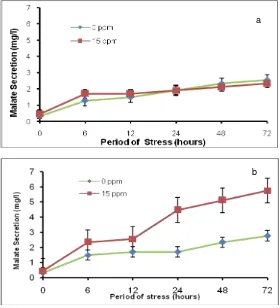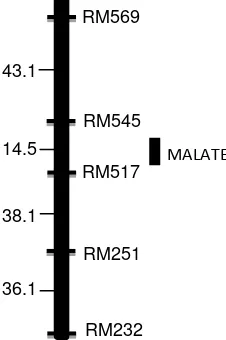Locus for Malate Secretion in Rice Chromosome 3
Miftahudin
1*, Irfan Martiansyah
1,
Dewi Indriyani Roslim
2, Tatik Chikmawati
11Department of Biology, Faculty of Mathematics and Natural Sciences, Bogor Agricultural University, Kampus IPB Darmaga, Bogor-Indonesia
2
Department of Biology, Faculty of Mathematics and Natural Sciences, Universiy of Riau Pekanbaru, Riau *Corresponding author: [email protected]
Abstract
Aluminum (Al) toxicity is a major limiting factor of rice production in acid soil. One of the tolerance mechanisms of plant to Al stress is the secretion of malate from plant root. The objective of this research is to identifiy quantitative triat loci (QTL) in chromosome 3 that controls malate secretion from rice root during the period of Al stress. The research was conducted in laboratory and green house. An F2 population derived from the cross between rice genotype Hawara Bunar and cultivar IR64 was used in this experiment. Analysis malate secretion was carried out based on enzymatic method. Rice simple sequence repeats from chromosome 3 were as moelcular marker. The mapping and QTL anaysis was performed using Mapmaker 3 and Mapmaker/QTL. The result showed that the malate secretion trait was normally distributed in the rice F2 population indicating that the trait is polygenic trait. A QTL for malate secretion was identified in the short arm of rice chromosome 3 located in between markers RM545 and RM517.
Keywords: Aluminum stress, Chromosome 3, Rice, QTL
Introduction
In general, aluminum tolerance in plant is genetically controlled, and the diversity of this trait can be found inter and intra plant species, including the member of Gramineae (Aniol and Gustafson 1990). Aluminum tolerance mechanism in plant can be divided into two models (Kochian 1995, Matsumoto 2000). First, internal detoxification mechanism, which is the mechanism of plant cells that are able to detoxify Al in the cell through organic acid chelation (Ma et 1998), vacuolar accumulation, protein detoxification, or reactive oxigen species reduction in the root cells (Ezaki et al 2000). Internal detoxification mechanism can also be achieved through activation of
calmodulin-independent NAD+ kinase (Aniol, 1991).
In the second model, Al is excluded from root tip cells through excluding Al accors plasma membrane, increasing rhizosfeer pH, producing exudate or secreting organic acid (Taylor 1991, Kochian 1995). Among those external mechanisms, organic acid secretion from root cells, such malate, citrate and oxalate, has been the most accepted mechanism. Organic acid secretion has important role in Al tolerance mechanism in wheat, rye and maize (Ryan et al 1995, Li et al 2002, Pellet et al 1995), however the similar role has not been elucidated in rice.
Several researchers have shown that organic acid secretion closely related to Al tolerance mechanis. However, the main factor that controlled organic acid secretion from root cells during Al stress still unclear. The recent finding showed that over expression of malate transporter gene that isolate from wheat could increase Al tolerance in transgenic tobacco, but the gene could not increase Al tolerance in rice (Sasaki et al 2004).
Materials and Method
Plant Materials
Rice genotype Hawara Bunar (Al-tolerant parent) and cultivar IR64 (Al-sensitive parent), F1 plants and F2 population derived from a cross between Hawara Bunar and IR64 were used in this research.
Nutrient culture technique for alumininum stress treatment
A simple hydrophonic technique was used to grow rice seedlings. Seeds were sterilized and soak in destilate water for 24 hours, and followed by germination for 48 hours. The seedlings with homogenous root length were put in sterofoamfloated on sterile minimal nutrient solution (Miftahudin et al. 2004) at pH 4.0 in 15 ml tube. A 15 ppm of Al in the form of AlCl3.6H2O was adminitered fro 24 hours. The seedlings were grown at room temperature in growth chamber with 12 hours light photoperiod.
Determination of malate secretion
Malate secretion was determined from F1 plants, 400 individual F2 population and both parents. Determination of malate secretion followed procedure as described by Delhaize et al. (1993). A 1.35 ml nutrient solution was sampled from each tube and was added with 1.5 ml buffer solution (0.4 M hydrazine and 0.5 M glycine, pH 9) and 0.1 ml 40 mM NAD. The reaction mixtures were thenincubated at room temperaturefor 30-60 min. The absorbance of the mixture was measured using spectrophotometer at =340 nm (absorbance 1). The mixture was then added with 5 δ εalate Dehidrogenase (5 mg/mδ, Sigma, USA), and the absorbance 2 was then measured.The difference between absorbance 1 and 2 indicated the amount of NADH produced and was used to calculate malate content of the solution as the following equation:
V x M
M = Molecular Weight of Malate (g/mol)
d = Cuvette width (cm)
= Absorption coefficientof ζADH at 340 nm = 6.3 (l/mmol.cm) ▲A = the difference between absorbance 1 dan 2
Moelcular marker analysis
Genetic mapping and QTL identification
Segregation analysis of molecular marker in the F2 population was performed using Chi
Squaretest pada = 0.05. Genetic linkage and QTL analyses usedMAPMAKERS/EXP ver 3.0
andMAPMAKERS/QTL ver 1.1, respectively.
Results and Discussion
Malate secretion in parent plants under Al stress
Malate secretion was analyzed from nutrient culture media that has bee used for growing F1, F2 and both parent seedling under 72 hours Al stress. The result showed that the malate secretion was higher when the seedlings were Al stressed and the secretion increse as the period of stress increase (Figure 1 and 2). The Al stress at thelevel of 15 ppm could differentiate malate secretion level from both parents. In rice cv IR64, although malate secretion increase as the increase of stress period, there was no significant difference between malate scretion at 0 and 15 ppm of Al stress along the 72 hour period of stress. Conversely, there wassignificant difference of malate secretion along the 72 hours stress period between 0 and 15 ppm Al stressin Hawara Bunar.The significant increase of malate secretion occurred when the seedlings were Al-stressed at 15 ppm at 72 hours. Therefore, the Al stress level of 15 ppm for 72 hour stress duration was used for phenotyping the F2 population. The result also showed that the average malate secretion from IR64, Hawara Buanr, F1 and F2 plants were 2.2, 3.8, 3.1 and 4.1 ppm, respectively.
Figure 1. Malate secretion from, rice root cv IR64 (a) and Hawara Bunar (b) along the 72 hour period of Al stress.
a
Distribution of Malate Secretion in F2 Population
Analysis of malate secretion in 400 individual F2 population showed normal distribution (Figure 2), which indicated that malate secretion character was multigenic controlled. It can be seen from the Figure 2 that the distribution curve rather skewed to the right and the secretion class falled to higher value than that both parents. This is suggested transgresive segregation phenomenon in this population. The average malate secretion of F2 population was also higher than that of Hawara Bunar.
When the malate secretion was grouped into two class of secretion based on the range of each parent malate secretion, malate scretion in F2 population followed monogenic inharitance. For individual F2 that secreted malate < 3 ppm, it was grouped into Al-sensitive plants, otherwise the plants were grouped into Al-tolerant plants. The Chi square test showed that the segregation fit to 3:1 ratio for Al-tolerant to Al-sensitive plants (Table1).
Figure 2. Distribution of malate secretion among individual F2 population.
Table 1. Chi square test for monogenic inharitance pattern of malate secretion in F2 population
Malate Secretion Class
Locus for malate secretion in rice chromosome 3
Analysis of genetic factor controlling malate secretion trait in rice was performed into two approaches. First, malate secretion trait was treated as polygenic trait based on the normal distribution of malate secretion in the F2 population, and second, malate secretion trait was treated as monogenic trait. The result showed that among the three chromosome that habe been analyzed, which were chromosome 1, 2 and 3, the locus for malate secretion trait was only possibly found om chromosome 3. QTL analysis based on poygenic trait indicated the presence of the QTL in the short arm of chromosome 3 in the region between markers RM%$% and RM517. However, the LOD score in that region maximum only 0.98, which was not enough to conclude that the QTL present in that region.
from RM517 toward RM545. The result of this research was similar to Nguyen et al (2001) who found QTL position for Al tolerance loci in the short arm of rice chromosome 3, but the position is rather shifted to other region of the short arm. This difference was due to the different rice background used in both experiments.
Figure 3. Genetic map of malate secretion locus in rice chromosome 3.
Conclussion
Rice secreted malate during the period of aluminum stress. Al tolerant rice genotype secreted malate more than that of Al-sensitive rice genotype. The secretion increased as the duration of stress increase. There was a locus controlling malate secretion located in the short arm of rice chromosome 3.
Acknowledgement
This research is supported by Basic Research Insentive Grant from Indonesian Ministry of Research and Technology Year 2009 granted to Dr. Miftahudin.
References
Aniol A (1991) Genetics of acid tolerant plant. In Wright RJ, Baligar VC, Murrmann RP (eds) Plant-Soil Interactions at Low pH. Kluwer Acad Publ, Dordrecht, pp.1007-10017
Aniol A, Gustafson JP (1990) Genetics of aluminum tolerance in agronomic plants. In Shaw AJ (ed) Heavy Metal Tolerance in Plants: Evolutionary Aspects. CRC Press, Boca Raton, Florida, pp.255-267 Delhaize E, Ryan PR, Randall PJ (1993b) Aluminum tolerance in wheat (Triticum aestivum L.). II.
Aluminum-stimulated excretion of malic acid from root apices. Plant Physiol 103:695-702
Ezaki B, Gardner RC, Ezaki Y, Matsumoto H (2000) Expression of aluminum-induced genes in transgenic Arabidopsis plants can ameliorate aluminum stress and/or oxidative stress. Plant Physiol 122:657-665 Kochian LV (1995) Cellular mechanisms of aluminum toxicity and resistance in plants. Annu Rev Plant Physiol
Plant Mol Biol 46: 237-260
Li XF, Ma JF, Matsumoto H (2002) Aluminum-induced secretion of both citrate and malate in rye. Plant and Soil 242:235-243
Ma JF, Hiradate S, Matsumoto H (1998) High aluminum resistance in buckwheat. II. Oxalic acid detoxifies aluminum internally. Plant Physiol 117:753-759
Matsumoto, H (2000) Cell biology of aluminum toxicity and tolerance in higher plants. Intl Rev Cytol 200:1-46
Miftahudin, Scoles GJ, Gustafson JP (2004) Development of PCR-based codominant markers flanking the Alt3 gene ini rye. Genome 47:231-238
Nguyen VT, Burow MD, Nguyen HT, Le BT, Le TD, Peterson AH (2001) Molecular mapping of genes conferring aluminum tolerance in rice (Oryza sativa L.). Theor Appl Genet 102:1002-1010
Pellet DM, Grunes DL, Kochian LV (1995) Organic acid exudation as an aluminum-tolerance mechanism in maize (Zea mays L) Plant 196:788-795
Ryan PR, Delhaize E, Randall PJ (1995) Characterization of Al-stimulated efflux of malate from the apices of Al-tolerant wheat roots. Planta 196:103-110
Taylor GJ (1991) Current views of the aluminum stress response: The physiological basis of tolerance. Curr Topics Plant Biochem Physiol 10:57-93


